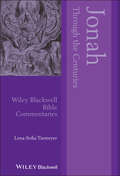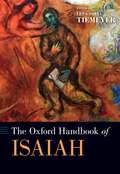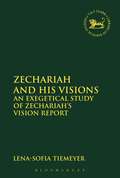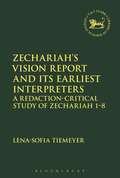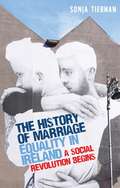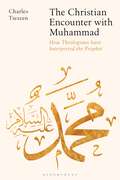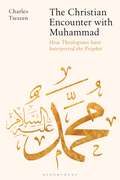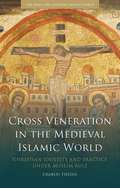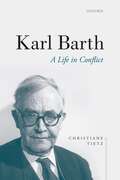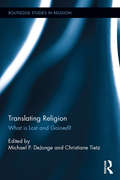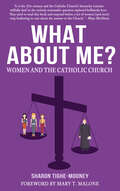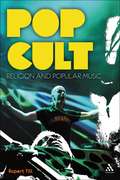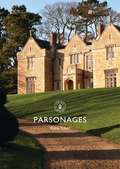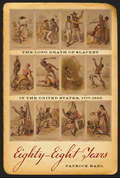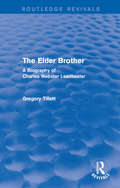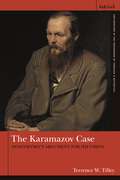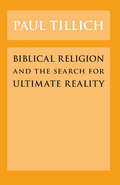- Table View
- List View
Jonah Through the Centuries (Wiley Blackwell Bible Commentaries)
by Lena-Sofia TiemeyerJonah Through the Centuries Jonah through the Centuries is a systematic examination of the reception history of the book of Jonah, long-recognized for its numerous theological implications and diverse interpretations. The first book of its kind written in English, this singular volume provides a lucid and coherent commentary on the most influential re-readings of Jonah in Jewish, Christian, Muslim, and secular traditions. Author Lena-Sofia Tiemeyer progresses slowly through the book of Jonah verse-by-verse—even word-by-word through key verses such as Jonah 1:1 and 2:1—to offer readers deep insight into the many and multifaceted interpretations of Jonah from early Jewish readings to modern literary retellings. Structured thematically rather than strictly chronologically, the text begins with the earliest interpretation and follows its trendline all the way through to modern times before turning to the next-oldest interpretation. The commentary covers a broad range of retellings in many languages and in various media including commentaries, sermons, prose, poetry, theatrical drama, art, and music, and analyses interpretations of both often-cited and lesser-known verses from the book of Jonah, interacting with an international range of literary retellings of the book of Jonah, offered in English translation. Throughout the text, the author demonstrates how all these retellings ultimately originate within the biblical text itself and highlights how many of the interpretations are fuelled and influenced by the interpreter’s religious background, cultural assumptions, and their preconceived notions of what the text should say. Jonah through the Centuries is an invaluable resource for educated clergy, undergraduate and graduate students in both seminaries and universities, scholars and academics, and general readers with interest in the reception of biblical texts in literature, art, and music.
The Oxford Handbook of Isaiah (Oxford Handbooks)
by Lena-Sofia TiemeyerThe book of Isaiah is without doubt one of the most important books in the Hebrew Bible/Old Testament, as evidenced by its pride of place in both Jewish and Christian traditions as well as in art and music. Most people, scholars and laity alike, are familiar with the words of Isaiah accompanied by the magnificent tones of Handel's 'Messiah'. Isaiah is also one of the most complex books due to its variety and plurality, and it has accordingly been the focus of scholarly debate for the last 2000 years. Divided into eight sections, The Oxford Handbook of Isaiah constitutes a collection of essays on one of the longest books in the Bible. They cover different aspects regarding the formation, interpretations, and reception of the book of Isaiah, and also offer up-to-date information in an attractive and easily accessible format. The result does not represent a unified standpoint; rather the individual contributions mirror the wide and varied spectrum of scholarly engagement with the book. The authors of the essays likewise represent a broad range of scholarly traditions from diverse continents and religious affiliations, accompanied by comprehensive recommendations for further reading.
Zechariah and His Visions: An Exegetical Study of Zechariah's Vision Report (The Library of Hebrew Bible/Old Testament Studies #605)
by Lena-Sofia TiemeyerDid Zechariah really see visions? This question cannot be definitely answered, so the idea must remain a hypothesis. Here, Tiemeyer shows that this hypothesis is nonetheless reasonable and instrumental in shedding light on matters in Zechariah's vision report that are otherwise unclear. Tracking through each verse of the text, the key exegetical problems are covered, including the topics of the distinction between visions and dreams, dream classification, conflicting sources of evidence for dream experiences, and rhetorical imagery as opposed to dream experience. Further attention is focused on the transmission of the divine message to Zechariah, with the key question raised of whether a visual or oral impression is described. Tiemeyer's study further demonstrates that Zech 1-6 depicts a three-tier reality. This description seeks to convey the seer's visionary experience to his readers. In a trance state, Zechariah communicates with the Interpreting Angel, while also receiving glimpses of a deeper reality known as the 'visionary world.'
Zechariah’s Vision Report and Its Earliest Interpreters: A Redaction-Critical Study of Zechariah 1-8 (The Library of Hebrew Bible/Old Testament Studies #626)
by Lena-Sofia TiemeyerIf Zechariah's vision report (Zechariah 1.8-6.8) reflects the seer's visionary experience, how does that impact our understanding of the gradual growth of the text? Lena-Sofia Tiemeyer builds on the work done in her previous book Zechariah and His Visions (Bloomsbury-T&T Clark, 2014), to demonstrate that the visionary material forms the primary textual layer. The oracular texts constitute chronologically later interpretations. Zechariah and/or later authors/editors sought guidance in the earlier vision accounts, and the oracular material reflects these endeavours. Tiemeyer's investigation is guided by the question: what is the latter material doing with the former? Is it enforcing, contradicting, or adding to it? Using a ratio composed of the difference between the intratexts and intertexts of Zech 1-8, Tiemeyer shows how this ratio is higher in the oracular material than in the visionary material. This difference points to the different origin and the different purpose of the two sets of material. While the earlier vision report draws on images found primarily in other biblical vision reports, the later oracular material has the characteristics of scribal interpretation. By drawing on earlier material, it seeks to anchor its proposed interpretations of the various vision accounts within the Israelite textual tradition. It is clear that the divine oracles were added to give, modify, and specify the meaning of the earlier vision report.
The history of marriage equality in Ireland: A social revolution begins
by Sonja TiernanTracing the campaign for marriage equality, this book highlights how this movement and the related referendum result have propelled Ireland from a country perceived as one repressed and controlled by the Catholic church to a country that is now admired as a leader in equality of human rights.
The history of marriage equality in Ireland: A social revolution begins
by Sonja TiernanTracing the campaign for marriage equality, this book highlights how this movement and the related referendum result have propelled Ireland from a country perceived as one repressed and controlled by the Catholic church to a country that is now admired as a leader in equality of human rights.
The Christian Encounter with Muhammad: How Theologians have Interpreted the Prophet (pdf)
by Charles TieszenThis book offers a fresh appraisal of Muhammad that considers the widest possible history of the ways in which Christians have assessed his prophethood.To medieval Christian communities, Muhammad-the leader of a religious and political community that grew quickly and with relative success-was an enigma. Did God really send him as a prophet with a revelation? Was the political success of the community he founded a divine validation? Or were he and his followers inspired by something evil? Despite their attempts, modern Christians continued to be puzzled by Muhammad. The Qur'an provided a framework for understanding and honouring Jesus; was it possible for Christians to reciprocate with regard to Muhammad?This book applies the same analysis to both medieval and modern assessments of Muhammad, in order to demonstrate the continuities and disparities present in literature from the two eras.
The Christian Encounter with Muhammad: How Theologians have Interpreted the Prophet
by Charles TieszenThis book offers a fresh appraisal of Muhammad that considers the widest possible history of the ways in which Christians have assessed his prophethood.To medieval Christian communities, Muhammad-the leader of a religious and political community that grew quickly and with relative success-was an enigma. Did God really send him as a prophet with a revelation? Was the political success of the community he founded a divine validation? Or were he and his followers inspired by something evil? Despite their attempts, modern Christians continued to be puzzled by Muhammad. The Qur'an provided a framework for understanding and honouring Jesus; was it possible for Christians to reciprocate with regard to Muhammad?This book applies the same analysis to both medieval and modern assessments of Muhammad, in order to demonstrate the continuities and disparities present in literature from the two eras.
Cross Veneration in the Medieval Islamic World: Christian Identity and Practice under Muslim Rule (Early and Medieval Islamic World)
by Charles TieszenOne of the most common religious practices among medieval Eastern Christian communities was their devotion to venerating crosses and crucifixes. Yet many of these communities existed in predominantly Islamic contexts, where the practice was subject to much criticism and often resulted in accusations of idolatry. How did Christians respond to these allegations? Why did they advocate the preservation of a practice that was often met with confusion or even contempt?
Karl Barth: A Life in Conflict
by Christiane TietzFrom the beginning of his career, Swiss theologian Karl Barth (1886-1968) was often in conflict with the spirit of his times. While during the First World War German poets and philosophers became intoxicated by the experience of community and transcendence, Barth fought against all attempts to locate the divine in culture or individual sentiment. This freed him for a deep worldly engagement: he was known as "the red pastor," was the primary author of the founding document of the Confessing Church, the Barmen Theological Declaration, and after 1945 protested the rearmament of the Federal Republic of Germany. Christiane Tietz compellingly explores the interactions between Barth's personal and political biography and his theology. Numerous newly-available documents offer insight into the lesser-known sides of Barth such as his long-term three-way relationship with his wife Nelly and his colleague Charlotte von Kirschbaum. This is an evocative portrait of a theologian who described himself as "God's cheerful partisan," who was honored as a prophet and a genial spirit, was feared as a critic, and shaped the theology of an entire century as no other thinker.
Karl Barth: A Life in Conflict
by Christiane TietzFrom the beginning of his career, Swiss theologian Karl Barth (1886-1968) was often in conflict with the spirit of his times. While during the First World War German poets and philosophers became intoxicated by the experience of community and transcendence, Barth fought against all attempts to locate the divine in culture or individual sentiment. This freed him for a deep worldly engagement: he was known as "the red pastor," was the primary author of the founding document of the Confessing Church, the Barmen Theological Declaration, and after 1945 protested the rearmament of the Federal Republic of Germany. Christiane Tietz compellingly explores the interactions between Barth's personal and political biography and his theology. Numerous newly-available documents offer insight into the lesser-known sides of Barth such as his long-term three-way relationship with his wife Nelly and his colleague Charlotte von Kirschbaum. This is an evocative portrait of a theologian who described himself as "God's cheerful partisan," who was honored as a prophet and a genial spirit, was feared as a critic, and shaped the theology of an entire century as no other thinker.
Translating Religion: What is Lost and Gained? (Routledge Studies in Religion)
by Christiane Tietz Michael P. DeJongeTranslating Religion advances thinking about translation as a critical category in religious studies, combining theoretical reflection about processes of translation in religion with focused case studies that are international, interdisciplinary, and interreligious. By operating with broad conceptions of both religion and translation, this volume makes clear that processes of translation, broadly construed, are everywhere in both religious life and the study of religion; at the same time, the theory and practice of translation and the advancement of translation studies as a field has developed in the context of concerns about the possibility and propriety of translating religious texts. The nature of religions as living historical traditions depends on the translation of religion from the past into the present. Interreligious dialogue and the comparative study of religion require the translation of religion from one tradition to another. Understanding the historical diffusion of the world’s religions requires coming to terms with the success and failure of translating a religion from one cultural context into another. Contributors ask what it means to translate religion, both textually and conceptually, and how the translation of religious content might differ from the translation of other aspects of human culture. This volume proposes that questions on the nature of translation find particularly acute expression in the domains of religion, and argues that theoretical approaches from translation studies can be fruitfully brought to bear on contemporary religious studies.
What About Me? Women and the Catholic Church
by Sharon Tighe-MooneyOne woman's investigation of the role of women in the Christian Church since its inception, as she counters the Roman Catholic church's argument for excluding them from the priesthood Details the gradual exclusion of women from positions of power as the Roman Catholic Church evolved. Accessible account from the viewpoint of an ordinary woman in the Church. Cover quotes from Mary McAleese, Fr. Tony Flannery and Mary T. Malone. What About Me? Women and the Catholic Church is an exploration by an ordinary woman, born into the Catholic faith of the arguments given to exclude her from ministry. Using her research skills, Sharon examines the New Testament, Christian writings and Papal documents. It is a personal quest to shed light on the story of women in the Christian movement from its earliest days to the present. The objective of the book is to explore, inform, speculate and question and it should appeal to a general audience. The context of the book is the 2010 move by Pope Benedict XVI to elevate the ‘crime’ of ordaining women to Catholic ministry and the subsequent censoring of religious personnel who questioned this edict. This book details a quest to find out where the strong antipathy towards women in the Roman Catholic Church's institutional mindset comes from.
Pop Cult: Religion and Popular Music
by Rupert TillAt a time when fundamentalism is on the rise, traditional religions are in decline and postmodernity has challenged any system that claims to be all-defining, young people have left their traditional places of worship and set up their own, in clubs, at festivals and within music culture. Pop Cults investigates the ways in which popular music and its surrounding culture have become a primary site for the location of meaning, belief and identity. It provides an introduction to the history of the interactions of vernacular music and religion, and the role of music in religious culture. Rupert Till explores the cults of heavy metal, pop stars, club culture and virtual popular music worlds, investigating the sex, drug, local and death cults of the sacred popular, and their relationships with traditional religions. He concludes by discussing how and why popular music cultures have taken on many of the roles of traditional religions in contemporary society.
Pop Cult: Religion and Popular Music
by Rupert TillAt a time when fundamentalism is on the rise, traditional religions are in decline and postmodernity has challenged any system that claims to be all-defining, young people have left their traditional places of worship and set up their own, in clubs, at festivals and within music culture. Pop Cults investigates the ways in which popular music and its surrounding culture have become a primary site for the location of meaning, belief and identity. It provides an introduction to the history of the interactions of vernacular music and religion, and the role of music in religious culture. Rupert Till explores the cults of heavy metal, pop stars, club culture and virtual popular music worlds, investigating the sex, drug, local and death cults of the sacred popular, and their relationships with traditional religions. He concludes by discussing how and why popular music cultures have taken on many of the roles of traditional religions in contemporary society.
Parsonages (Shire Library)
by Kate TillerFrom the middle ages to the present day the houses of local clergy – parsonages, vicarages and rectories – have been among the most significant buildings in parishes throughout England. Architecturally some of the best and most fully documented domestic buildings, their history is that of the small and medium sized house, from medieval vernacular to the bespoke designs of leading Victorian architects and the more modest homes of today's clergy. The lives lived in the parsonage, factual and fictional (from Austen to Trollope and the televised struggles of 'Rev' in London's East End in the 2010s) reveal not just a building, but a hub of spiritual and secular activity, at the heart of local life and linking it to wider, national history. In this engaging introduction, Kate Tiller brings together the architectural and social histories of the parsonage, drawing on the evidence of buildings, archival and literary accounts, and contemporary and modern images, to depict parsonages, their occupants and how their histories may be traced.
Parsonages: Improvisation And The Theatre (Shire Library #786)
by Kate TillerFrom the middle ages to the present day the houses of local clergy – parsonages, vicarages and rectories – have been among the most significant buildings in parishes throughout England. Architecturally some of the best and most fully documented domestic buildings, their history is that of the small and medium sized house, from medieval vernacular to the bespoke designs of leading Victorian architects and the more modest homes of today's clergy. The lives lived in the parsonage, factual and fictional (from Austen to Trollope and the televised struggles of 'Rev' in London's East End in the 2010s) reveal not just a building, but a hub of spiritual and secular activity, at the heart of local life and linking it to wider, national history. In this engaging introduction, Kate Tiller brings together the architectural and social histories of the parsonage, drawing on the evidence of buildings, archival and literary accounts, and contemporary and modern images, to depict parsonages, their occupants and how their histories may be traced.
The Elder Brother: A Biography of Charles Webster Leadbeater (Routledge Revivals)
by Gregory TillettA leading figure in the Theosophical Society, Leadbeater was a prolific author, writing on subjects ranging from Buddhism, Masonic history and the origins of Christianity through to the power of thought and the fourth dimension. Leadbeater was also the force behind Annie Besant, the discoverer and educator if Krishnamurti, and became Presiding Bishop of the Liberal Catholic Church. For all his influence Charles Leadbeater remains largely unknown as a man. This biography, first published in 1982, dispels many of the mysteries surrounding his life, and Leadbeater emerges as neither evil degenerate or infallible saint, but as a complex and eccentric adventurer into the realm of the occult. This title will be of particular interest to students of history and theology.
The Elder Brother: A Biography of Charles Webster Leadbeater (Routledge Revivals)
by Gregory TillettA leading figure in the Theosophical Society, Leadbeater was a prolific author, writing on subjects ranging from Buddhism, Masonic history and the origins of Christianity through to the power of thought and the fourth dimension. Leadbeater was also the force behind Annie Besant, the discoverer and educator if Krishnamurti, and became Presiding Bishop of the Liberal Catholic Church. For all his influence Charles Leadbeater remains largely unknown as a man. This biography, first published in 1982, dispels many of the mysteries surrounding his life, and Leadbeater emerges as neither evil degenerate or infallible saint, but as a complex and eccentric adventurer into the realm of the occult. This title will be of particular interest to students of history and theology.
The Karamazov Case: Dostoevsky's Argument for His Vision
by Terrence W. TilleyThis is a new interpretation of Dostoevsky's novel The Brothers Karamazov that scrutinizes it as a performative event (the “polyphony” of the novel) revealing its religious, philosophical, and social meanings through the interplay of mentalités or worldviews that constitute an aesthetic whole. This way of discerning the novel's social vision of sobornost' (a unity between harmony and freedom), its vision of hope, and its more subtle sacramental presuppositions, raises Tilley's interpretation beyond the standard “theology and literature” treatments of the novel and interpretations that treat the novel as providing solutions to philosophical problems.Tilley develops Bakhtin's thoughtful analysis of the polyphony of the novel using communication theory and readers/hearer response criticism, and by using Bakhtin's operatic image of polyphony to show the error of taking "faith vs. reason", argues that at the end of the novel, the characters learned to carry on, in a quiet shared commitment to memory and hope.
The Karamazov Case: Dostoevsky's Argument for His Vision
by Terrence W. TilleyThis is a new interpretation of Dostoevsky's novel The Brothers Karamazov that scrutinizes it as a performative event (the “polyphony” of the novel) revealing its religious, philosophical, and social meanings through the interplay of mentalités or worldviews that constitute an aesthetic whole. This way of discerning the novel's social vision of sobornost' (a unity between harmony and freedom), its vision of hope, and its more subtle sacramental presuppositions, raises Tilley's interpretation beyond the standard “theology and literature” treatments of the novel and interpretations that treat the novel as providing solutions to philosophical problems.Tilley develops Bakhtin's thoughtful analysis of the polyphony of the novel using communication theory and readers/hearer response criticism, and by using Bakhtin's operatic image of polyphony to show the error of taking "faith vs. reason", argues that at the end of the novel, the characters learned to carry on, in a quiet shared commitment to memory and hope.
Biblical Religion and the Search for Ultimate Reality
by Paul TillichDr. Tillich shows here that in spite of the contrast between philosophical and biblical language, it is neither necessary nor possible to separate them from each other. On the contrary, all the symbols used in biblical religion drive inescapably toward the philosophical quest for being. An important statement of a great theologian's position, this book presents an eloquent plea for the essential function of philosophy in religious thought.
Biblical Religion and the Search for Ultimate Reality
by Paul TillichDr. Tillich shows here that in spite of the contrast between philosophical and biblical language, it is neither necessary nor possible to separate them from each other. On the contrary, all the symbols used in biblical religion drive inescapably toward the philosophical quest for being. An important statement of a great theologian's position, this book presents an eloquent plea for the essential function of philosophy in religious thought.
Biblical Religion and the Search for Ultimate Reality
by Paul TillichDr. Tillich shows here that in spite of the contrast between philosophical and biblical language, it is neither necessary nor possible to separate them from each other. On the contrary, all the symbols used in biblical religion drive inescapably toward the philosophical quest for being. An important statement of a great theologian's position, this book presents an eloquent plea for the essential function of philosophy in religious thought.
Biblical Religion and the Search for Ultimate Reality
by Paul TillichDr. Tillich shows here that in spite of the contrast between philosophical and biblical language, it is neither necessary nor possible to separate them from each other. On the contrary, all the symbols used in biblical religion drive inescapably toward the philosophical quest for being. An important statement of a great theologian's position, this book presents an eloquent plea for the essential function of philosophy in religious thought.
